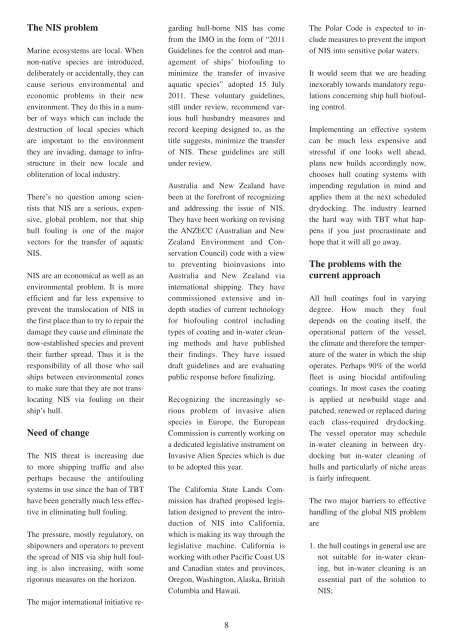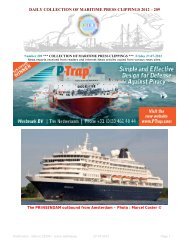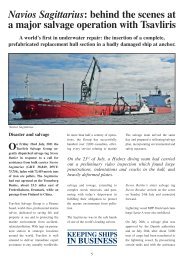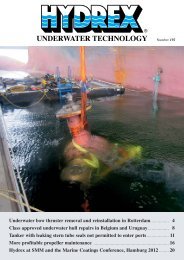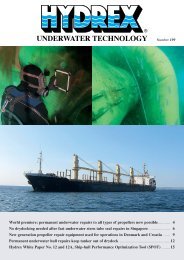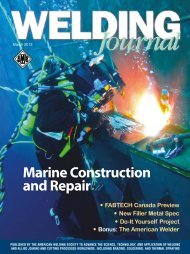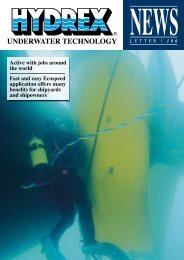Ecospeed newsletter December 2012 - Hydrex Underwater ...
Ecospeed newsletter December 2012 - Hydrex Underwater ...
Ecospeed newsletter December 2012 - Hydrex Underwater ...
Create successful ePaper yourself
Turn your PDF publications into a flip-book with our unique Google optimized e-Paper software.
The NIS problem<br />
Marine ecosystems are local. When<br />
non-native species are introduced,<br />
deliberately or accidentally, they can<br />
cause serious environmental and<br />
economic problems in their new<br />
environment. They do this in a number<br />
of ways which can include the<br />
destruction of local species which<br />
are important to the environment<br />
they are invading, damage to infrastructure<br />
in their new locale and<br />
obliteration of local industry.<br />
There’s no question among scientists<br />
that NIS are a serious, expensive,<br />
global problem, nor that ship<br />
hull fouling is one of the major<br />
vectors for the transfer of aquatic<br />
NIS.<br />
NIS are an economical as well as an<br />
environmental problem. It is more<br />
efficient and far less expensive to<br />
prevent the translocation of NIS in<br />
the first place than to try to repair the<br />
damage they cause and eliminate the<br />
now-established species and prevent<br />
their further spread. Thus it is the<br />
responsibility of all those who sail<br />
ships between environmental zones<br />
to make sure that they are not translocating<br />
NIS via fouling on their<br />
ship’s hull.<br />
Need of change<br />
The NIS threat is increasing due<br />
to more shipping traffic and also<br />
perhaps because the antifouling<br />
systems in use since the ban of TBT<br />
have been generally much less effective<br />
in eliminating hull fouling.<br />
The pressure, mostly regulatory, on<br />
shipowners and operators to prevent<br />
the spread of NIS via ship hull fouling<br />
is also increasing, with some<br />
rigorous measures on the horizon.<br />
The major international initiative regarding<br />
hull-borne NIS has come<br />
from the IMO in the form of “2011<br />
Guidelines for the control and management<br />
of ships’ biofouling to<br />
minimize the transfer of invasive<br />
aquatic species” adopted 15 July<br />
2011. These voluntary guidelines,<br />
still under review, recommend various<br />
hull husbandry measures and<br />
record keeping designed to, as the<br />
title suggests, minimize the transfer<br />
of NIS. These guidelines are still<br />
under review.<br />
Australia and New Zealand have<br />
been at the forefront of recognizing<br />
and addressing the issue of NIS.<br />
They have been working on revising<br />
the ANZECC (Australian and New<br />
Zealand Environment and Conservation<br />
Council) code with a view<br />
to preventing bioinvasions into<br />
Australia and New Zealand via<br />
international shipping. They have<br />
commissioned extensive and indepth<br />
studies of current technology<br />
for biofouling control including<br />
types of coating and in-water cleaning<br />
methods and have published<br />
their findings. They have issued<br />
draft guidelines and are evaluating<br />
public response before finalizing.<br />
Recognizing the increasingly serious<br />
problem of invasive alien<br />
species in Europe, the European<br />
Commission is currently working on<br />
a dedicated legislative instrument on<br />
Invasive Alien Species which is due<br />
to be adopted this year.<br />
The California State Lands Commission<br />
has drafted proposed legislation<br />
designed to prevent the introduction<br />
of NIS into California,<br />
which is making its way through the<br />
legislative machine. California is<br />
working with other Pacific Coast US<br />
and Canadian states and provinces,<br />
Oregon, Washington, Alaska, British<br />
Columbia and Hawaii.<br />
8<br />
The Polar Code is expected to include<br />
measures to prevent the import<br />
of NIS into sensitive polar waters.<br />
It would seem that we are heading<br />
inexorably towards mandatory regulations<br />
concerning ship hull biofouling<br />
control.<br />
Implementing an effective system<br />
can be much less expensive and<br />
stressful if one looks well ahead,<br />
plans new builds accordingly now,<br />
chooses hull coating systems with<br />
impending regulation in mind and<br />
applies them at the next scheduled<br />
drydocking. The industry learned<br />
the hard way with TBT what happens<br />
if you just procrastinate and<br />
hope that it will all go away.<br />
The problems with the<br />
current approach<br />
All hull coatings foul in varying<br />
degree. How much they foul<br />
depends on the coating itself, the<br />
operational pattern of the vessel,<br />
the climate and therefore the temperature<br />
of the water in which the ship<br />
operates. Perhaps 90% of the world<br />
fleet is using biocidal antifouling<br />
coatings. In most cases the coating<br />
is applied at newbuild stage and<br />
patched, renewed or replaced during<br />
each class-required drydocking.<br />
The vessel operator may schedule<br />
in-water cleaning in between drydocking<br />
but in-water cleaning of<br />
hulls and particularly of niche areas<br />
is fairly infrequent.<br />
The two major barriers to effective<br />
handling of the global NIS problem<br />
are<br />
1. the hull coatings in general use are<br />
not suitable for in-water cleaning,<br />
but in-water cleaning is an<br />
essential part of the solution to<br />
NIS;


